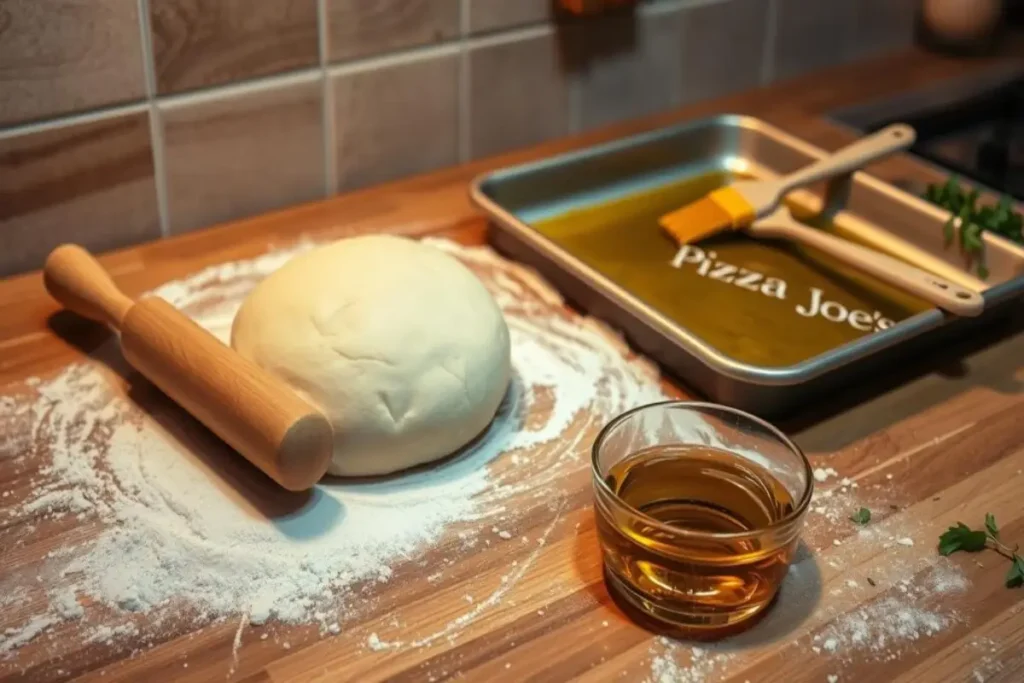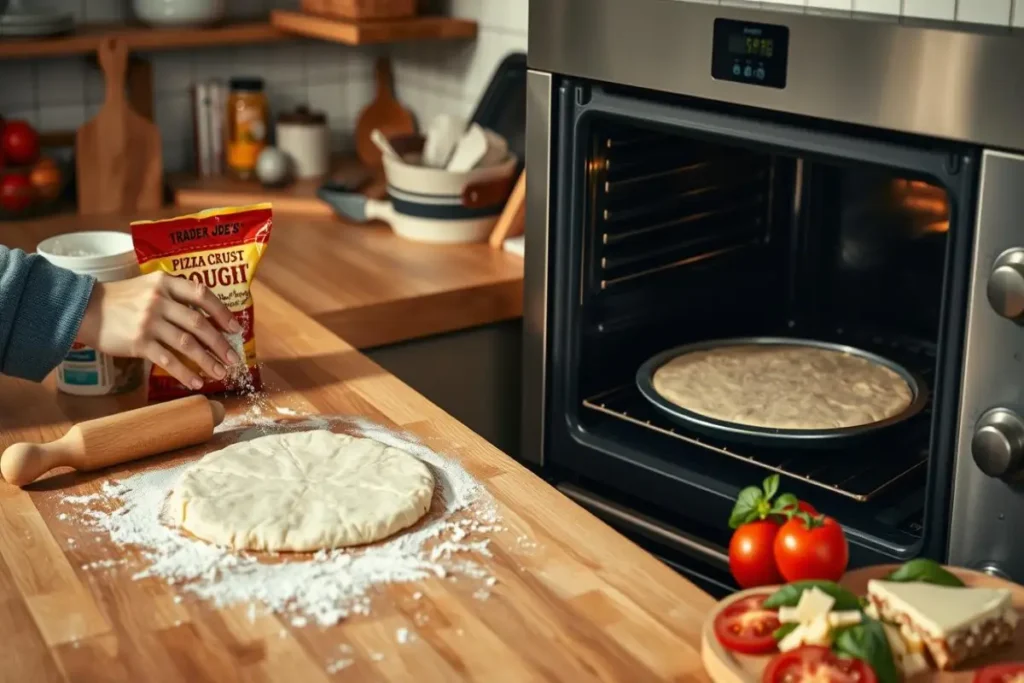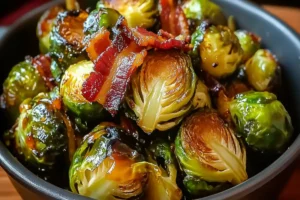Every weekend, I turn my kitchen into a pizza paradise. Trader Joe’s pizza dough is my go-to secret. It helped me go from a pizza newbie to a confident home chef. Pairing it with a Smoothie mit Mango makes the experience even better.
Making the perfect homemade pizza is an art. With Trader Joe’s dough, you can make pizzas as good as your favorite pizzeria. These five tips will help you improve your pizza-making skills.
Trader Joe’s dough is super convenient. It costs just $2 per package and makes two 10-inch pizzas. You don’t need to be a pro to make a meal that wows family and friends. Pair your pizza with Delicious Ono Fish for a unique culinary experience.
This guide will teach you everything about Trader Joe’s pizza dough. You’ll learn about different dough types and how to bake like a pro. Soon, you’ll be making pizzas as good as any pizzeria.
Get ready to make your weekend cooking amazing. Whether it’s crafting pizzas or preparing Chinese dishes, you’re about to become the pizza master you’ve always wanted to be. Your culinary journey starts now with Trader Joe’s pizza dough!
Table of contents
- Understanding Trader Joe’s Pizza Dough Options
- Essential Equipment for Perfect Trader Joe’s Pizza Dough Creations
- Proper Trader Joe’s Pizza Dough Temperature and Handling Tips
- The Science Behind Trader Joe’s Pizza Dough Rising
- Stretching and Shaping Trader Joe’s Pizza Dough Like a Pro
- Pan Preparation and Oil Usage for Trader Joe’s Pizza Dough
- Perfect Sauce Application Methods
- Cheese Selection and Layering
- Optimal Baking Temperature Guide for Trader Joe’s Pizza Dough
- Creating Restaurant-Style Crust with Trader Joe’s Pizza Dough
- Common Mistakes to Avoid When Using Trader Joe’s Pizza Dough
- Creative Topping Combinations for Trader Joe’s Pizza Dough
- Storing and Reheating Tips for Trader Joe’s Pizza Dough
- Advanced Trader Joe’s Pizza Dough Techniques
- Conclusion
- FAQs About Trader Joe’s Pizza Dough
Understanding Trader Joe’s Pizza Dough Options
Exploring Trader Joe’s pizza dough can boost your homemade pizza skills. You’ll find the right dough for your cooking style and taste.
Trader Joe’s has a wide range of pizza doughs. Each one suits different cooking methods and tastes. Let’s look at what makes each variety special:
Plain Pizza Dough Features
The plain pizza dough is great for anyone. It has:
- A neutral taste for adding your own flavors
- An easy-to-shape texture
- Keeps well in the fridge for 2-3 days
- Freezes well for up to 3 months
Traditional Pizza Dough Characteristics
Traditional pizza dough adds a real pizzeria feel to your kitchen. It’s known for:
- A deep, true pizza flavor
- Creating beautiful leopard spots when baked
- Helping make a crispy crust
Garlic & Herb Variety Specifics
The Garlic & Herb pizza dough adds a bold flavor. It’s packed with:
| Characteristic | Details |
|---|---|
| Price | $1.49 per package |
| Package Weight | 16 ounces |
| Pizza Size | 12″ pizza from 10 ounces of dough |
| Sodium Content | 350 mg per 2 ounces |
Pro tip: For the best results, let Trader Joe’s pizza dough warm up at room temperature for 30 minutes. This makes it easier to stretch.
"The secret to great pizza is not just in the toppings, but in the dough itself." - Pizza Enthuasiast
Essential Equipment for Perfect Trader Joe’s Pizza Dough Creations
Making a tasty homemade pizza is more than just using Trader Joe’s pizza dough. The right tools can make a big difference. A few key items will help you get that crispy crust everyone loves.
Here are the must-have tools for making pizzas like a pro in your kitchen:
- Pizza Stone: Creates authentic crispy pizza crust
- Pizza Peel: Helps transfer pizzas smoothly
- Digital Oven Thermometer: Ensures precise temperature
- Pizza Cutter: Provides clean, professional slices
Having the right equipment is key to making great homemade pizzas.
| Equipment | Purpose | Recommended Temperature |
|---|---|---|
| Pizza Stone | Crisp pizza crust bottom | 500°F |
| Pizza Peel | Easy pizza transfer | N/A |
| Digital Thermometer | Accurate oven tracking | 450-475°F |
"The right tools can elevate your pizza from good to gourmet!" - Professional Chef
Pro tip: Preheat your pizza stone for at least 30 minutes before baking. This will give you that perfect crispy crust. Your Trader Joe’s pizza dough will appreciate the extra effort!
Proper Trader Joe’s Pizza Dough Temperature and Handling Tips
Mastering Trader Joe’s pizza dough handling is key. It involves understanding temperature and preparation techniques. The right temperature is essential for a tasty pizza dough experience.
Room Temperature Guidelines
Starting with the right dough preparation is vital. Remove Trader Joe’s pizza dough from the fridge. Let it rest at room temperature for 30-60 minutes before making your pizza.
- Ideal resting time: 30-60 minutes
- Room temperature makes dough easier to stretch
- Prevents dough from tearing
Storage and Thawing Tips
Storing your dough properly keeps it fresh and easy to work with. Here are some tips for the best results:
- Keep it refrigerated until you’re ready to use it
- Thaw at room temperature
- Use it within the recommended time
Handling Sticky Dough Solutions
Sticky dough can be tough, but there are ways to handle it:
| Problem | Solution |
|---|---|
| Too sticky | Lightly dust with flour |
| Hard to stretch | Let it rest for an extra 10 minutes |
| Uneven texture | Gently knead to spread out moisture |
"The secret to perfect pizza dough is patience and gentle handling." - Professional Pizza Chef
By following these tips, you can turn Trader Joe’s pizza dough into a delicious base for your pizzas.
The Science Behind Trader Joe’s Pizza Dough Rising
Learning about pizza dough rising can make your homemade pizza truly special. Yeast is key in making the crust just right. It turns simple ingredients into a tasty base for your favorite toppings.
The rising process involves several key scientific principles:
- Yeast activation begins at specific temperatures
- Fermentation creates complex flavor profiles
- Gluten development determines crust texture
When you work with pizza dough, yeast starts eating sugars and making carbon dioxide. This creates tiny air bubbles that make your crust light and airy. Fresh yeast contains about 70% water, which affects how your homemade pizza dough develops.
"Baking is a science, and pizza dough is its most delicious experiment." - Anonymous Pizza Chef
Temperature is very important for dough rising. Your kitchen’s warmth affects how fast yeast works and how much the dough grows. Usually, pizza dough doubles in size after about 45 minutes of proofing.
Pro tip for pizza dough lovers: Keep your dough at a consistent warm temperature between 75-80°F for the best rising. This temperature helps yeast work its magic, making a perfectly textured crust for your homemade pizza.
Stretching and Shaping Trader Joe’s Pizza Dough Like a Pro
Making the perfect pizza crust takes skill and practice. Whether you use Trader Joe’s easy pizza dough or make your own, learning to stretch and shape is key. It can turn your homemade pizza into something truly special.
Knowing how to work with pizza dough is essential for a crust like the ones in restaurants. Each method has its own benefits for texture and look.
Hand Stretching Method
Hand stretching is the classic way to make a perfect pizza crust. It keeps the dough’s air bubbles in, making it lighter and more authentic.
- Start with room temperature dough
- Gently press the dough center with fingertips
- Rotate and stretch using the back of your hands
- Allow gravity to help stretch the dough naturally
Rolling Pin Approach
The rolling pin method makes a pizza crust that’s even and uniform. It’s great if you want your pizza to have the same thickness everywhere.
- Dust your surface with flour
- Roll from the center outwards
- Rotate the dough periodically for even stretching
- Aim for a thin, even layer
Thickness Control Tips
Getting the right thickness for your pizza crust depends on your method and what you like. Try both hand stretching and rolling to see what works best for you.
"The secret to a great pizza is in the stretch!" - Professional Pizza Chef
Pro tip: Let your Trader Joe’s pizza dough rest at room temperature for at least 4 hours before stretching. This lets the yeast work, making the crust more flavorful and fluffy.
Pan Preparation and Oil Usage for Trader Joe’s Pizza Dough

Making the perfect homemade pizza begins with pan preparation. With Trader Joe’s recipes, the right pan and oil make all the difference. It can change your pizza-making journey.
Here are key tips for preparing your Trader Joe’s pizza dough:
- Use a baking sheet or pizza pan with low sides
- Choose a pan that heats evenly
- Get your pan ready before stretching the dough
The trick to avoiding stickiness and getting a golden crust is olive oil application. Experts say to use about 1 tablespoon of olive oil per baking sheet. Spread it all over for even coverage.
| Pan Type | Oil Amount | Best For |
|---|---|---|
| Baking Sheet | 1 tablespoon | Crispy Crust |
| Pizza Stone | Light brushing | Authentic Texture |
| Cast Iron Skillet | 2 teaspoons | Deep Dish Style |
"The right pan and oil can elevate your homemade pizza from good to extraordinary!" - Pizza Craft Magazine
Pro tip: Let your Trader Joe’s pizza dough rest at room temperature for 30 minutes before stretching. This makes it easier to spread and prevents it from tearing.
Perfect Sauce Application Methods
Making a tasty homemade pizza begins with getting the sauce right. Trader Joe’s has a great selection of pizza sauces. They can make your pizza go from good to great.
Sauce Selection Guide
Trader Joe’s has many sauce options for your pizza:
- Classic Marinara: Rich and tangy
- Arrabbiata: Spicy and robust
- Pesto: Herbaceous and flavorful
Choose a sauce that matches your toppings. Pro tip: Use about 4 ounces of sauce for a 12-inch pizza.
Proper Distribution Techniques
To get the sauce just right, start in the middle of your dough. Spread it out in a spiral with the back of a spoon. Make sure to leave a little room around the edges to keep the crust crispy.
"Less is more when it comes to pizza sauce - aim for a thin, even layer that allows other flavors to shine."
Here are some tips for spreading sauce:
- Use 2-3 tablespoons for a 10-inch pizza
- Spread it evenly, avoiding pools
- Keep it 1/2 inch from the edge
By using these methods, you’ll make a pizza that’s as good as any from a restaurant.
Cheese Selection and Layering

Making the perfect homemade pizza begins with picking the right cheese. Trader Joe’s offers a wide range of cheeses that can elevate your pizza. It’s important to know how to choose and layer cheese for the best taste and texture.
When making your Trader Joe’s pizza dough, keep these cheese tips in mind:
- Choose high-quality cheese varieties
- Balance moisture and melting properties
- Mix different cheese types for complex flavor
Here’s a guide for picking the right cheese for your homemade pizza:
| Cheese Type | Flavor Profile | Melting Quality |
|---|---|---|
| Whole Milk Mozzarella | Mild, creamy | Excellent stretch |
| Quattro Formaggio Blend | Complex, sharp | Rich texture |
| Provolone | Tangy, robust | Smooth melting |
For the best results, layer your cheese strategically. Begin with a thin layer of mozzarella, then add your secondary cheeses. This method ensures even melting and prevents a soggy crust.
"The secret to great pizza is not just the ingredients, but how you combine them" - Pizza Artisan
Pro tip: Grate your cheese fresh for the best melting. Trader Joe’s recipes suggest using about 8 oz of primary cheese and 4 oz of complementary varieties for the perfect balance.
Optimal Baking Temperature Guide for Trader Joe’s Pizza Dough
Mastering pizza dough baking is all about the right temperature and techniques. To get the perfect crust, you need to set your oven just right. This turns your Trader Joe’s dough into a crispy, tasty treat.
Temperature is key when baking pizza. It’s what makes your pizza taste like it came from a restaurant. Both pros and home cooks agree: the right heat is essential.
Conventional Oven Settings
For the best pizza, follow these temperature tips:
- Preheat your oven to 425-500°F (218-260°C)
- Put the oven rack in the middle for even heat
- Use a baking sheet or pizza stone for the best results
Pizza Stone Recommendations
Pizza stones make your pizza crust crispy. Here’s how to use them:
- Preheat the stone for at least 30 minutes
- Dust the stone with semolina flour to prevent sticking
- Transfer pizza quickly to keep the stone hot
"The secret to perfect pizza is in the heat and the technique." - Professional Pizza Chef
Timing is key when baking pizza. Most pizzas need about 10 minutes at high heat.
| Baking Method | Temperature | Cooking Time |
|---|---|---|
| Conventional Oven | 475°F | 8-12 minutes |
| Pizza Stone | 500°F | 6-10 minutes |
| Air Fryer | 375°F | 5-7 minutes |
Pro tip: Always watch your pizza closely to avoid burning and get a perfectly golden crust.
Creating Restaurant-Style Crust with Trader Joe’s Pizza Dough

To make Trader Joe’s pizza dough into a top-notch crust, you need to know some tricks. It’s all about how you handle the dough and bring out its best taste.
Experts say the key to a great pizza crust is in the prep work. Here are some tips to get that perfect crust:
- Let the Trader Joe’s pizza dough sit at room temperature for 30-60 minutes before stretching
- Use a pizza stone or preheated baking sheet to make it crispier
- Stretch the dough gently to keep its air bubbles
- Heat your oven to 450°F to 475°F
Want a different crust style? Just tweak your method:
| Crust Style | Technique | Texture Result |
|---|---|---|
| Thin & Crispy | Roll dough very thin | Crunchy, cracker-like |
| Thick & Chewy | Minimal stretching | Soft, bread-like interior |
| Focaccia-Style | Create deep dimples | Airy, fluffy texture |
"The art of pizza making is about understanding your dough's personality and coaxing out its best qualities." - Pizza Craft Magazine
Working with Trader Joe’s pizza dough is special. The plain pizza dough gets very puffy. The traditional dough gets cool “leopard spotting” when baked hot.
Try out different ways to find your ideal pizza crust. Remember, the more you practice, the better you’ll get!
Common Mistakes to Avoid When Using Trader Joe’s Pizza Dough
Making the perfect homemade pizza can be tricky, even with easy pizza dough from Trader Joe’s. Knowing the common mistakes helps you make delicious pizzas every time.
Temperature Challenges in Pizza Making
Temperature is key in making a great pizza. Cold dough can mess up your whole cooking experience. Here’s what to do with Trader Joe’s pizza dough:
- Let dough sit at room temperature for at least 20 minutes before stretching
- Don’t use refrigerated dough straight from the package
- Let dough rest and expand for the best texture
Handling Errors to Prevent Tough Dough
Handling dough wrong can make it tough. To avoid this, do the following:
- Don’t handle dough too much
- Stretch it gently
- Don’t knead it too hard after you’ve prepared it
"Treat your pizza dough like a delicate ingredient, not a wrestling opponent."
Understanding these important points about making homemade pizza will improve your skills. You’ll make pizzas that taste like they’re from a restaurant, right in your kitchen.
Creative Topping Combinations for Trader Joe’s Pizza Dough

Take your homemade pizza to the next level with Trader Joe’s unique ingredients. A few special toppings can turn your pizza into a masterpiece. Let your culinary creativity shine with these trader joe’s recipes.
- Mediterranean Inspiration: Combine crumbled feta, kalamata olives, and spinach
- Sweet and Savory: Mix prosciutto with fig jam and arugula
- Spicy Vegetarian: Layer roasted red peppers, jalapeños, and goat cheese
It’s important to balance flavors for a great pizza. Think about texture, intensity, and how ingredients work together. This will help you create a pizza that’s truly special.
| Topping Category | Recommended Ingredients | Flavor Profile |
|---|---|---|
| Protein | Prosciutto, Salami, Grilled Chicken | Rich and Savory |
| Cheese | Goat Cheese, Ricotta, Smoked Mozzarella | Creamy and Complex |
| Vegetables | Roasted Artichokes, Caramelized Onions, Arugula | Fresh and Earthy |
"The secret to an amazing pizza is not just the ingredients, but how they work together." - Pizza Artisan
Remember, less is more. Too many toppings can mess up your pizza’s flavors. Stick to 3-4 ingredients that complement each other for the best results.
Storing and Reheating Tips for Trader Joe’s Pizza Dough
Turning Trader Joe’s pizza dough into quick meals is easy. Just store and reheat it right to keep it tasty and fresh.
Leftover Storage Methods
Keeping your pizza fresh is key. Store slices in an airtight container or wrap them in foil. This way, you can enjoy your pizza for up to 3-4 days.
- Use shallow containers to prevent moisture buildup
- Separate pizza slices with parchment paper
- Avoid stacking heavy items on top of stored pizza
Reheating Techniques
Reheating pizza right is important. It keeps the crust crispy and the cheese melted. Here are some ways to reheat your pizza like a pro.
| Reheating Method | Temperature | Time | Result |
|---|---|---|---|
| Oven | 375°F | 10-12 minutes | Crispy crust, evenly heated |
| Skillet | Medium heat | 3-4 minutes | Crispy bottom, melted cheese |
| Air Fryer | 375°F | 5-7 minutes | Crunchy texture |
"The secret to great leftover pizza is all in the reheating technique!" - Pizza Enthuasiast
Don’t use the microwave. It can make your pizza soggy. Instead, use the oven or skillet to keep it fresh.
Remember, proper storage and reheating can turn your leftover pizza into another delightful quick meal!
Advanced Trader Joe’s Pizza Dough Techniques
To make your Trader Joe’s pizza dough amazing, you need to learn some advanced techniques. These methods can turn your homemade pizza into something truly special. Professional pizza makers know that how you make it is just as important as what you put in it.
Cold fermentation is a big deal for pizza dough lovers. Letting your Trader Joe’s pizza dough chill in the fridge for 24-48 hours makes it taste better. It brings out deeper, more complex flavors that make your pizza even more delicious.
"Great pizza isn't made in moments, it's crafted through technique and patience." - Pizza Artisan
Key Advanced Techniques
- Cold Fermentation: Enhance flavor development
- Par-Baking: Create crispier crust foundations
- Dough Stretching: Improve texture and consistency
When using Trader Joe’s pizza dough, try these pro tips:
| Technique | Benefit | Time Investment |
|---|---|---|
| Cold Fermentation | Deeper Flavor | 24-48 hours |
| Par-Baking | Crispier Crust | 5-7 minutes |
| Gentle Stretching | Better Texture | 3-5 minutes |
Experts say to keep your dough at 1/4 inch thickness when rolling it out. This helps it have the right texture without falling apart.
Using these advanced techniques will make your homemade pizza stand out. You’ll impress everyone with your new pizza-making skills.
Conclusion
You've learned how to make tasty homemade pizza with Trader Joe's pizza dough. You now know the basics of dough, stretching, and baking. This knowledge lets you turn a simple ingredient into a delicious dish. Trader Joe's pizza dough is very versatile. You can try many flavors and cooking ways, such as using it to make a Creamy Spinach pizza or even a Quiche Bake. Whether you pick Plain or Traditional dough, each has its own special touch. The secret is to play with temperature, toppings, and baking times. Making great pizza is like an art that gets better with time. Every pizza you make helps you get better at making homemade pizza. With what you've learned, you can make pizzas as good as those in restaurants. You can use Trader Joe's dough to show off your cooking skills. Keep practicing and trying new things. You'll find your own way of making pizza. You'll also enjoy the fun of making your own pizzas at home.
FAQs About Trader Joe’s Pizza Dough
Can you get pizza dough at Trader Joe's?
Yes, Trader Joe’s offers fresh pizza dough in their refrigerated section. It’s an affordable and convenient option for making homemade pizza.
How to make pizza using Trader Joe's pizza dough?
To make pizza, let the dough sit at room temperature for 20-30 minutes. Stretch it into your desired shape, add your favorite toppings, and bake in a preheated oven at 450-500°F until golden and bubbly.
How long should Trader Joe's pizza dough sit out?
Trader Joe’s pizza dough should sit out at room temperature for about 20-30 minutes. This allows the dough to relax, making it easier to stretch and shape.
How many calories are in Trader Joe's pizza dough?
One serving of Trader Joe's pizza dough (¼ of the package, approximately 57g) contains about 120-130 calories, depending on the type. Always check the package for exact nutritional information.
What types of pizza dough does Trader Joe’s offer?
Trader Joe’s has several pizza dough options, including plain, whole wheat, and garlic & herb. Each type offers a unique taste and texture, perfect for customizing your pizza.
How do I properly thaw Trader Joe’s pizza dough?
To thaw Trader Joe’s pizza dough, remove it from the package and let it sit at room temperature for 20-30 minutes. This makes it easier to stretch. Avoid leaving it out too long to prevent over-softening.
Can I freeze Trader Joe’s pizza dough?
Yes, Trader Joe’s pizza dough can be frozen. If you don’t plan to use it immediately, place the unopened dough in the freezer. Thaw in the fridge overnight and let it come to room temperature before use.
What equipment do I need to make pizza with Trader Joe’s dough?
To make pizza, you’ll need a pizza stone or baking sheet, a pizza cutter, parchment paper, and a good oven. Optional tools like a pizza peel, rolling pin, and kitchen thermometer can enhance your experience.
How do I prevent the dough from sticking when stretching?
Dust your hands and work surface with flour to prevent sticking. Alternatively, use a little olive oil on your hands and the dough. Work on a clean surface and avoid overworking the dough.
What’s the best way to stretch Trader Joe’s pizza dough?
Hand stretching works best. Press the dough from the center outward, letting gravity help. Rotate it as you stretch to maintain even thickness. Be gentle to avoid tearing the dough.
What baking temperature is recommended for Trader Joe’s pizza dough?
For a perfect crust, preheat your oven to 450-500°F. Use a pizza stone for a crispy base and preheat it in the oven for the best results.
How long can I store leftover pizza made with Trader Joe’s dough?
Store leftover pizza in an airtight container in the fridge for 3-4 days. To reheat, use an oven or toaster oven at 350°F to keep the crust crispy.
Can I use Trader Joe’s pizza dough for something other than traditional pizza?
Yes! Trader Joe’s pizza dough is versatile. Use it to make calzones, garlic knots, breadsticks, or even savory tarts for a creative twist.
A Note from the Chef
Let us know if you try it, your feedback fuels our passion!







3 thoughts on “Trader Joe’s Pizza Dough: 5 Tips for Perfect Results”